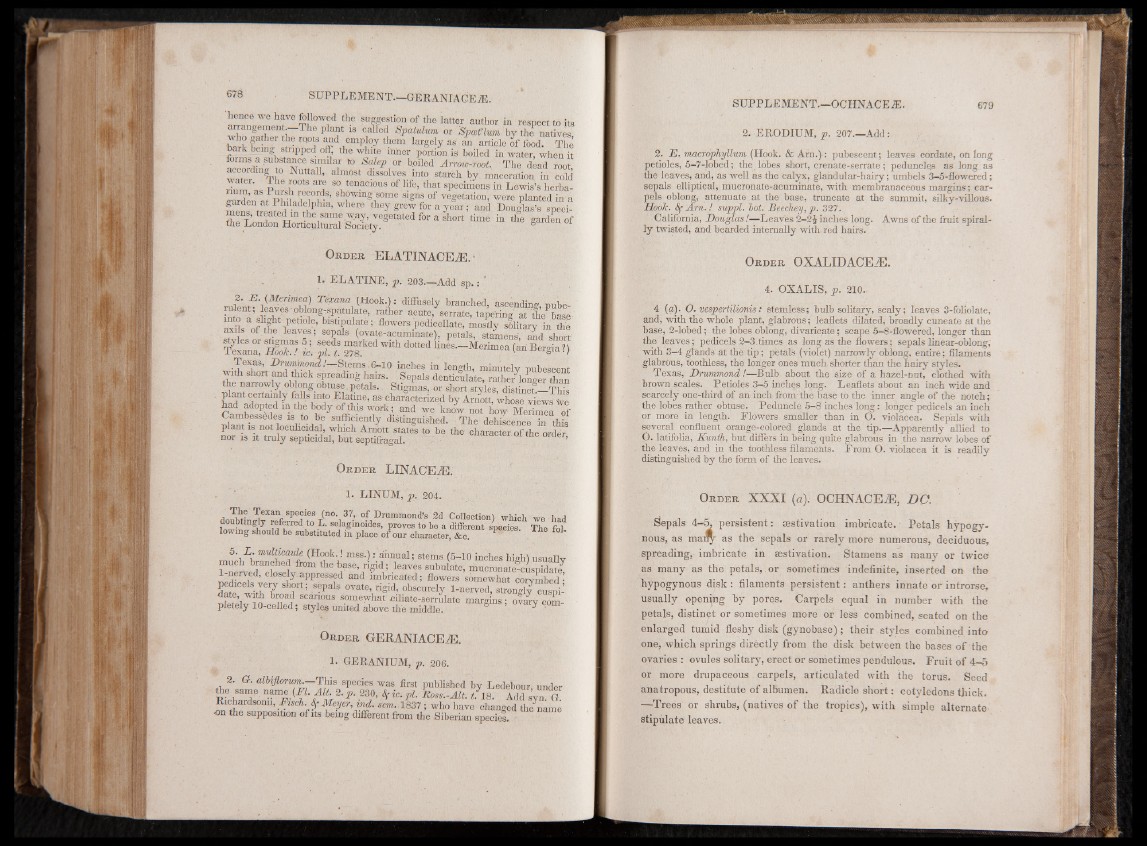
hence we have followed the suggestion of the latter author in respect to its
arrangement— The plant is called Spatulum or 'Spmt’lum by the natives
tle 1'QOt1s “ d employ them largely as an article of food. Thé
hark being stripped off, the white inner portion is boiled in water, when it
forms a substance similar to Salep or b.oiled Arrow-root. The dead root
wa to m The Nlf a11’ alm°St dlSS0lves int0 starcl1 by maceration in cold
rium as Pmsk ? ^ Ü specimens in Lewis’s herba- assess
Or d e r ELATINAOEiE. ■
ELATINE, p. 203— Add sp.
r„i» f ' l ) Texana (Hook.): diffusely branched, ascending, puberulent;
leaves-.oblong.spatulate, rather acute, serrate, tapering at the^ase-
mto a slight-petiole, bistipulate; flowers pedicellate, mostly solitary in the
axils of the leaves; sepals (ovate-acuminate), petals, stamens, and short
Texana" h S U - y U . g f u , :g f * * $ ^ “ Merimea (an Bergia ?)
• Stems. 6-10 inches in length, minutely pubescent
with short and thick spreading hairs. Sepals denticulate, rathe/longer than
e narrowly oblopg obtuse. petals.. Stigmas, or short styles, distinct__This
plant certainly falls mto Elatine, as-characterized by Arnott, whose views we
had adopted in the body of this work; and we 'know not how Merimea of
Cambessedes is to be sufficiently distinguished. ■ The dehiscence in this
plant is not loculicidal, which Arnott states to be the character of the order
nor is it truly septicidal, but septifragal. order,
Or d e r LINACE^E.
1. LINUM, p. 204.
TKbo Texan, species (no. 37, of Drummond’s 2d Collection) which we had
doubtingly referred to L. selagmoides, proves to be a different species The fol
lowing should be substituted in place of our character, &c. .
'5\ L: mult*c<™lf (Hook.! mss.): ahnual; stems (5-10 inches high) usually
much branched from the base, rigid; leaves subulate, mucronatemfispidate7
l-nerved, closely.appressed and imbricated; flowers somewhat corymbed •
pediceis very short; sepals ovate, rigid, obscurely l-nerved, s t r o n g l™ pi-
bji°ad various somewhat ciliate-serrulate margins; ova™ completely
10-celled; styles united above the middle. ^ '
Or d e r GERANIACEiE.
1. GERANIUM, p. 206.
2. G. albiflorunu—1Thisi species was first published by Ledebour, under
the same name (EZ. Alt. 2. p. 230, 8f ic. pi. Ross.-Alt. t. 18. Add syn. G
Richardsonu, Fisch. Sf Meyer, md. sem. 1837 ; who have changed tb/name
on the supposition of its being different from the Siberian species
2. ERODIUM, p. 207— Add:
2. E , macrophyllum (Hook. & Am .): pubescent; leaves cordate, on long
petioles, 5-7-lobed; the lobes short, crenate-serrate; peduncles as long as
the leaves, and, as well as the calyx, glandular-hairy; umbels 3-5-flowared;
sepals elliptical, mucronate-acuminate, with membranaceous margins; carpels
oblong, attenuate at the base, truncate at the summit, silky-villous.
Hook. 8f Am. ! svppl. bot. Beechey, p. 327.
California, Douglas!—Leaves 2—2 i inches long. Awns of the fruit spirally
twisted, and bearded internally with red hairs.
Or d e r OXALIDACE.E.
4. OXALIS, p. 210.
4 (a), O. vespertilionis: stemless; bulb solitary, scaly; leaves 3-foliolate,
and, with the whole plant, glabrous; leaflets dilated, broadly cuneate at the
base, 2-lobed; the lobes oblong, divaricate; scape 5-8-flowered, longer than
the leaves; pedicels 2-3.times as long as the flowers; sepals linear-oblong,’
with 3-4 glands at the tip; petals (violet) narrowly oblong, entire; filaments
glabrous, toothless, the longer ones much shorter than the hairy styles.
Texas, Drummond!—Bulb about the size of a hazel-nut, clothed with
brown scales. Petioles 3-5 inches long. Leaflets about an inch wide and
scarcely one-third of an inch from-the base to the inner angle of the notch;
the lobes rather obtuse. Peduncle 5-8 inches long : longer pedicels an inch
or more in length. Flowers smaller than in O. violacea. Sepals with
several confluent orange-colored glands at the tip.—Apparently allied to
O. latifolia, Kunth, but differs in being quite glabrous in the narrow lobes of
the leaves, and in the toothless filaments. From O. violacea it is readily
distinguished by the form of the leaves.
Or d e r XXXI (a). OCHNACEiE, D C .
Sepals 4 -5 . persistent: aestivation imbricate. Petals hypogy-
nous, as matf^ as the sepals or rarely more numerous, deciduous,
spreading, imbricate in aestivation. Stamens as many or twice
as many as the petals, or sometimes indefinite, inserted on the
hypogynous disk : filaments p e rsisten t: anthers innate or introrse,
usually opening by pores. Carpels equal in number with the
petals, distinct or sometimes more or less combined, seated on the
enlarged tumid fleshy disk (gynob a se); their styles combined into
one, which springs directly from the disk between the bases o f the
ovaries : ovules solitary, erect or sometimes pendulous. Fruit o f 4 -5
or more drupaceous carpels, articulated with the torus. Seed
anatropous, destitute o f albumen. Radicle sh o r t: cotyledons thick.
—Trees or shrubs, (natives o f the tropics), with simple alternate
stipulate leaves.